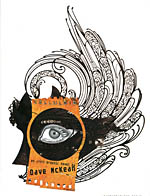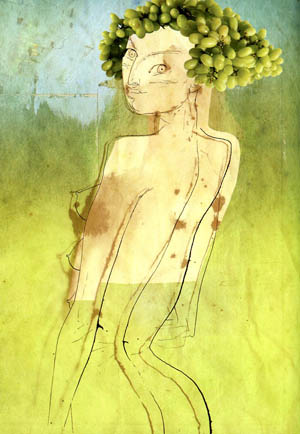 By Dave McKean
By Dave McKean
232 pages, color
Published by Fantagraphics
I’m a big fan of Dave McKean’s. Often dreamed of owning one of his covers. Read each issue of Cages as it was published and fell in love with it over and over again. Bought half a dozen copies of Cages and Pictures that Tick to give as gifts. Even bought some of his photography books over the years. So a new McKean graphic novel should have been the best news I’d heard all year. But now that I’ve read and re-read Celluloid, it’s hard to keep a bit of disappointment from creeping in, even as I can still admire its pluses.
 McKean’s new graphic novel is wordless, telling the story of a woman whose partner is still at work, and finds herself bored. When an old film projector showing an unfocused erotic film is discovered, though, it allows her to walk into the world of film itself, moving through a series of scenes until she finally arrives at the climax she’s been desiring ever since the man in her life stayed at work rather than came home. If it sounds simple, that’s because it is.
McKean’s new graphic novel is wordless, telling the story of a woman whose partner is still at work, and finds herself bored. When an old film projector showing an unfocused erotic film is discovered, though, it allows her to walk into the world of film itself, moving through a series of scenes until she finally arrives at the climax she’s been desiring ever since the man in her life stayed at work rather than came home. If it sounds simple, that’s because it is.
I’d known not to expect a retread of Cages (which I’ll admit has its flaws, but I still love it anyway) but I found myself slightly taken aback by how little there is in the way of actual plot in Celluloid. It’s a mood piece, pure and simple, and while I’m not against that nature of story even that didn’t seem to entirely work for me. Most of the different scenes feel a little cold in terms of storytelling; it’s hard to warm to McKean’s protagonist, and her wandering from one style of art to the next feels almost random in its progression. At times Celluloid feels less like a narrative and more like a series of pieces of art that were collected together due to similar themes.
 The one saving grace for Celluloid is some of the pieces of art themselves. It is entertaining to watch McKean move through his various styles, from sharp pen and ink lines for the "real world" scenes, to what appears to be a mixture of paint, photography, and computer effects that shift and turn as the book progresses. Some work better than others; the usage of fruit photography alongside lines and paints is inventive, with grapes for hair and other fruit subbing in for more delicate parts of the female anatomy. But even then, while I appreciate the styles on display, there’s a computer-generated sequence towards the end that feels almost like a parody of McKean’s more recent works (overly textured and messy with hundreds of images stitched together like a collage), and there’s never any strong motion or energy to the pages. I’d have been happy to immerse myself fully in McKean’s art, but there’s a stiffness present that keeps the reader from fully getting drawn into the finished book.
The one saving grace for Celluloid is some of the pieces of art themselves. It is entertaining to watch McKean move through his various styles, from sharp pen and ink lines for the "real world" scenes, to what appears to be a mixture of paint, photography, and computer effects that shift and turn as the book progresses. Some work better than others; the usage of fruit photography alongside lines and paints is inventive, with grapes for hair and other fruit subbing in for more delicate parts of the female anatomy. But even then, while I appreciate the styles on display, there’s a computer-generated sequence towards the end that feels almost like a parody of McKean’s more recent works (overly textured and messy with hundreds of images stitched together like a collage), and there’s never any strong motion or energy to the pages. I’d have been happy to immerse myself fully in McKean’s art, but there’s a stiffness present that keeps the reader from fully getting drawn into the finished book.
Having read Celluloid a couple of times, it’s hard to keep from being a little disappointed. It’s not a bad book, but it suffers a great deal in comparison to McKean’s other creations. As an experiment it’s interesting, and some of the styles of art on display are breathtaking. But it’s hard to shake the nagging thought that Celluloid should have been great, based on its pedigree. And while I respect what McKean wanted to do with Celluloid, "great" is not a word I’d use to describe it, alas. This is a book for McKean completists above all else, I think.
Purchase Links: Amazon.com | Powell’s Books
